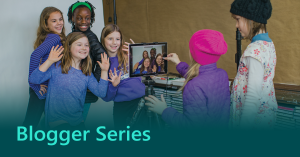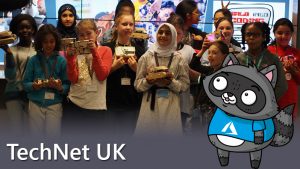
Another one bites the dust: How schools can improve the digital skills gender gap

“I’m not going to take GCSE Computer Science anymore,” said my 14 (going on 21) year old daughter. She’s a YouTube junkie, Overwatch fanatic and – since seeing Bohemian Rhapsody – a Queen superfan. I tried hard to hide the look of disappointment on my face as I asked her why.
I work as Talent Acquisition Lead for Microsoft in Middle East and Africa, and formerly for the UK, too. So, I spend my days working with my team to hire technical talent, while trying to ensure that we attract a healthy proportion of females into the recruiting process – and it is tough. In the UK, a recent PWC research study found that only 15% of people working in STEM in UK roles were female; only 3% of females said a career in technology was their first choice.
Don’t stop me now
Don’t get me wrong, although I’d love my daughter to turbo-charge her digital skills, getting deeply into artificial intelligence, machine learning, or data science, she made it clear that this was not the path for her. But surely continuing to study Computer Science to GCSE level, or A-Level at a push, wasn’t too much to expect?
We know that the gender gap in digital skills starts at school. Females make up just 10% of A-Level computer science students, which in turn has a major impact on the pipeline of talent going into the technology industry. So challenging is the issue that the UK government has just announced investment in an initiative aimed at tackling this problem. In April 2019, the ‘Gender Balance in Computing’ research project received £2.4 million of funding from the Department of Education to trial a number of schemes aimed at improving girls’ participation in computing.
Having been at Microsoft for 19 happy years, my daughter also started at Microsoft (at the workplace nursery) when she was a year old. She’s since spent a fair bit of time during school holidays with me in our family friendly office, drawing on the walls (it’s allowed, I promise), playing on the Xboxes, shooting some pool, playing on the indoor swings (yes, really), and periodically making the most of the Christmas parties or holiday ‘learn-to-code’ events. She had access to lots of role models and the awesome roles in an amazing office environment. And similarly, she wasn’t put off by any gender imbalance in the classroom; she goes to an all-girls school.
Two of the commonly cited reasons for this gender disparity are a lack of role models and lack of knowledge around the great career opportunities. So, which of these was it that put off my daughter? It was neither.
Another one bites the dust
The reason that she’s dropping Computer Science is shockingly simple. As a keen musician, singer, performer and – as I mentioned – Queen fan, when her school’s timetabling wouldn’t permit students to take the combination of Music GCSE with Computer Science GCSE, her mind was made up. You could combine Computer Science with any other subject, just not Music. Simple as that.
Students are advised, in the school ‘exam options’ booklet, that “for a balanced curriculum you should choose one arts subject (art, drama, music), a humanities subject (business, geography, history) and a technology subject (cooking and nutrition or Graphics).”
Back in 2013, an Institute of Physics report entitled ’Closing Doors’ shows that the majority of schools fail to encourage subject choices in a gender neutral way, which narrows children’s choices. The timetabling issue along with the school options booklet are classic examples of this; sending a subtle but effective message steering girls away from the subject. A perfectly logical combination of subjects becomes unusual, impossible, against the norm. And leading the technology list with Cooking and no mention of Computing, really?

I want to break free
If we’re serious about closing the digital skills gap for girls, then tech companies like Microsoft need to take the lead. We need to promote programs drawing more women into the sector. This is the next generation workforce. They’ll be sorely missed if schools and businesses don’t start encouraging them right now. They must offer better visibility to role models and the great range of STEM careers available. Such innovations include Microsoft’s DigiGirlz initiative for secondary school pupils, the Codess community, and our Women Think Next networking events.
At the same time, schools should remove each and every blocker to girls gaining digital skills and studying STEM subjects, especially Computer Science. All the role models in the world won’t help if a simple scheduling issue or a clumsily written booklet closes the door. In this case, it did for more than one female student.
Raising the issue, my daughter’s school quickly responded, acknowledging the feedback, promising to remediate for next year. They even invited me to deliver some careers sessions.
My daughter loves school. She’s getting a wonderful education with teachers who do an amazing job every day. She’s still pursuing other STEM subjects, aspiring to a career in science and particularly Astronomy. And who is her new role model? None other than PhD Astronomer and Queen guitarist, Brian May. Don’t stop her now.
Find out more
Empower the young people of today to create the world of tomorrow
About the author
 Georgina is Head of Talent Acquisition for Middle East and Africa, with nearly 20 years’ service at Microsoft. She’s focused on managing the recruiting teams across the MEA region, recruiting talent primarily for the sales and marketing, and services organisations. Prior to moving into recruitment, Georgina was a leader in the Microsoft Services team, managing the delivery of professional services to Microsoft’s Premier Support customers. She’s passionate about coaching and developing individuals to achieve their potential, with an interest in diversity and inclusion. Georgina is based in the UK with her husband, two children and three stepchildren.
Georgina is Head of Talent Acquisition for Middle East and Africa, with nearly 20 years’ service at Microsoft. She’s focused on managing the recruiting teams across the MEA region, recruiting talent primarily for the sales and marketing, and services organisations. Prior to moving into recruitment, Georgina was a leader in the Microsoft Services team, managing the delivery of professional services to Microsoft’s Premier Support customers. She’s passionate about coaching and developing individuals to achieve their potential, with an interest in diversity and inclusion. Georgina is based in the UK with her husband, two children and three stepchildren.




